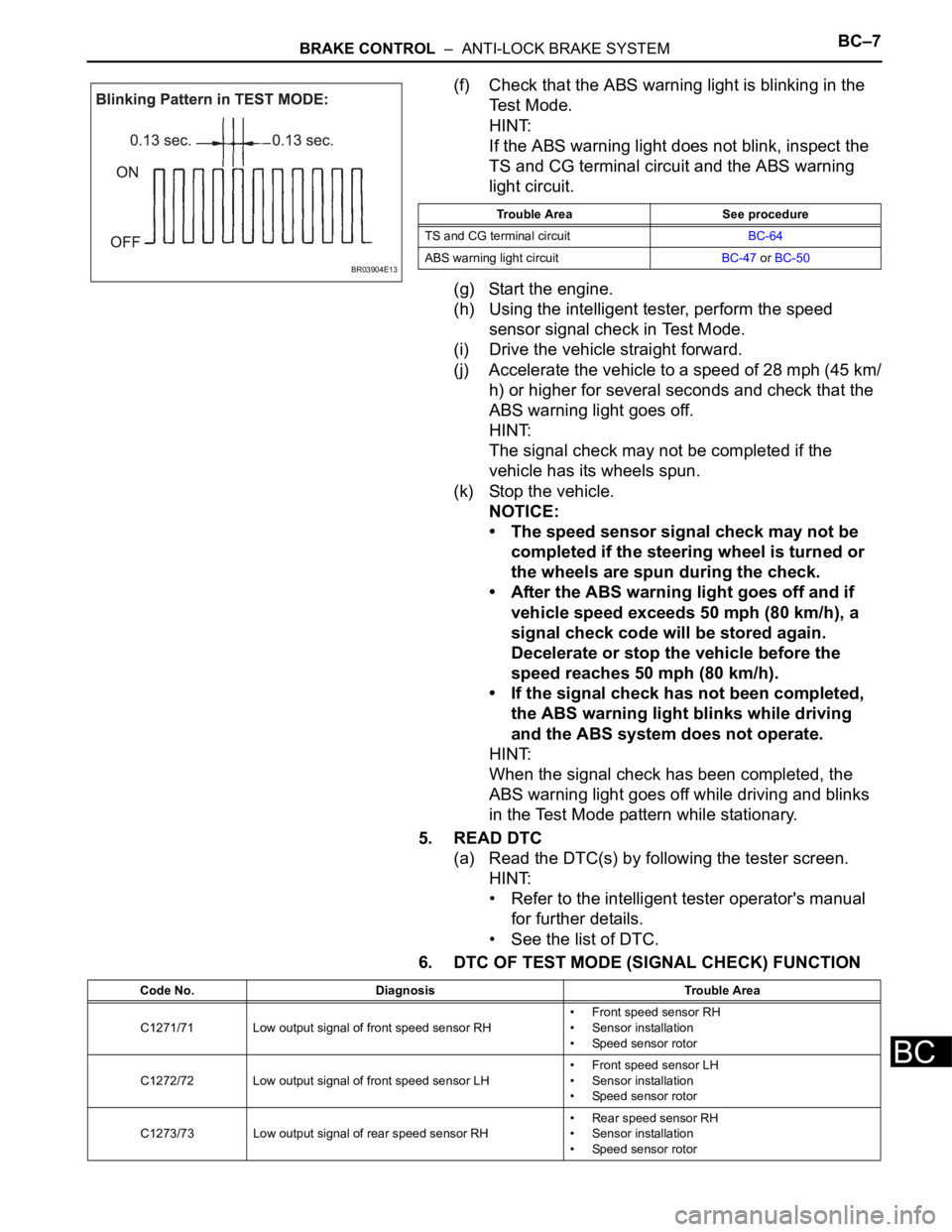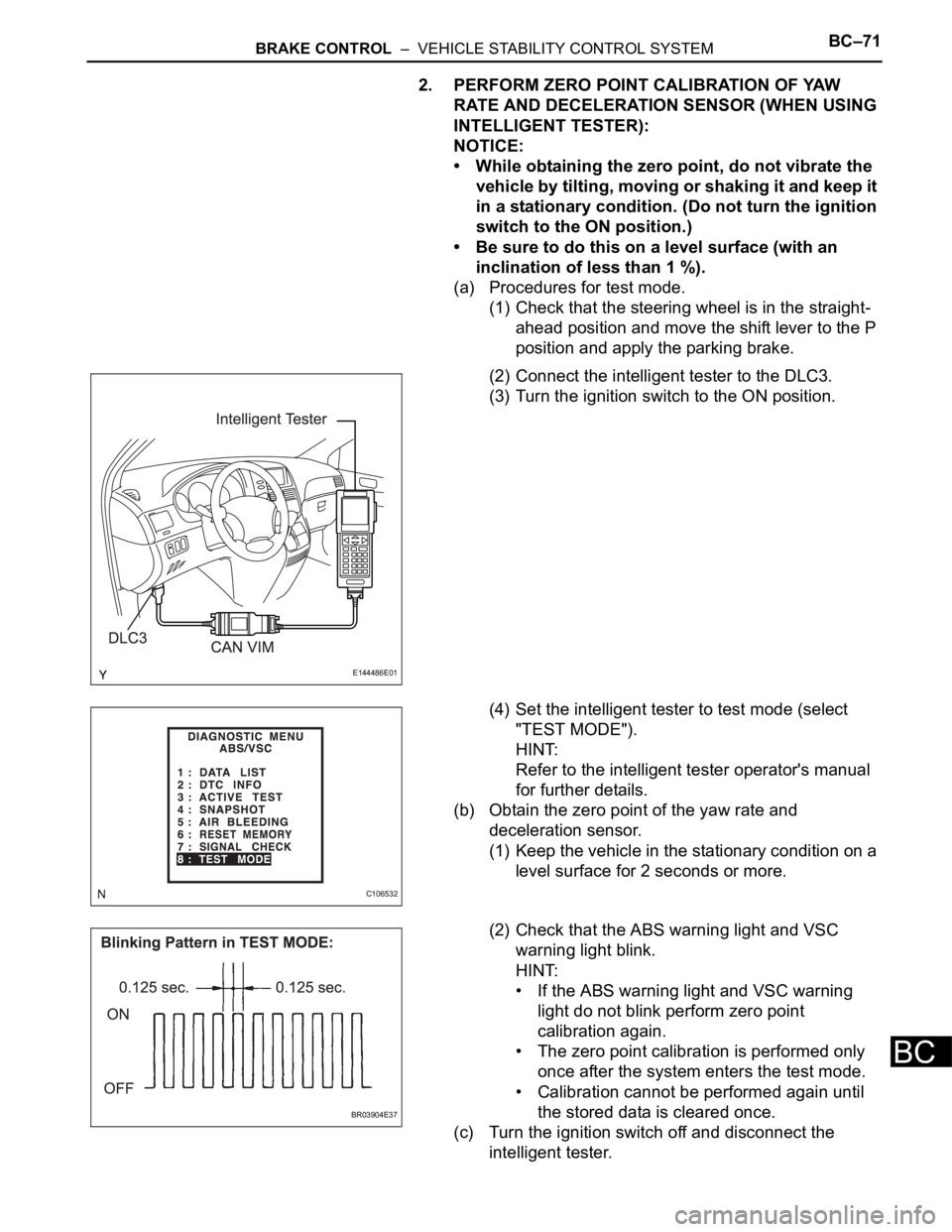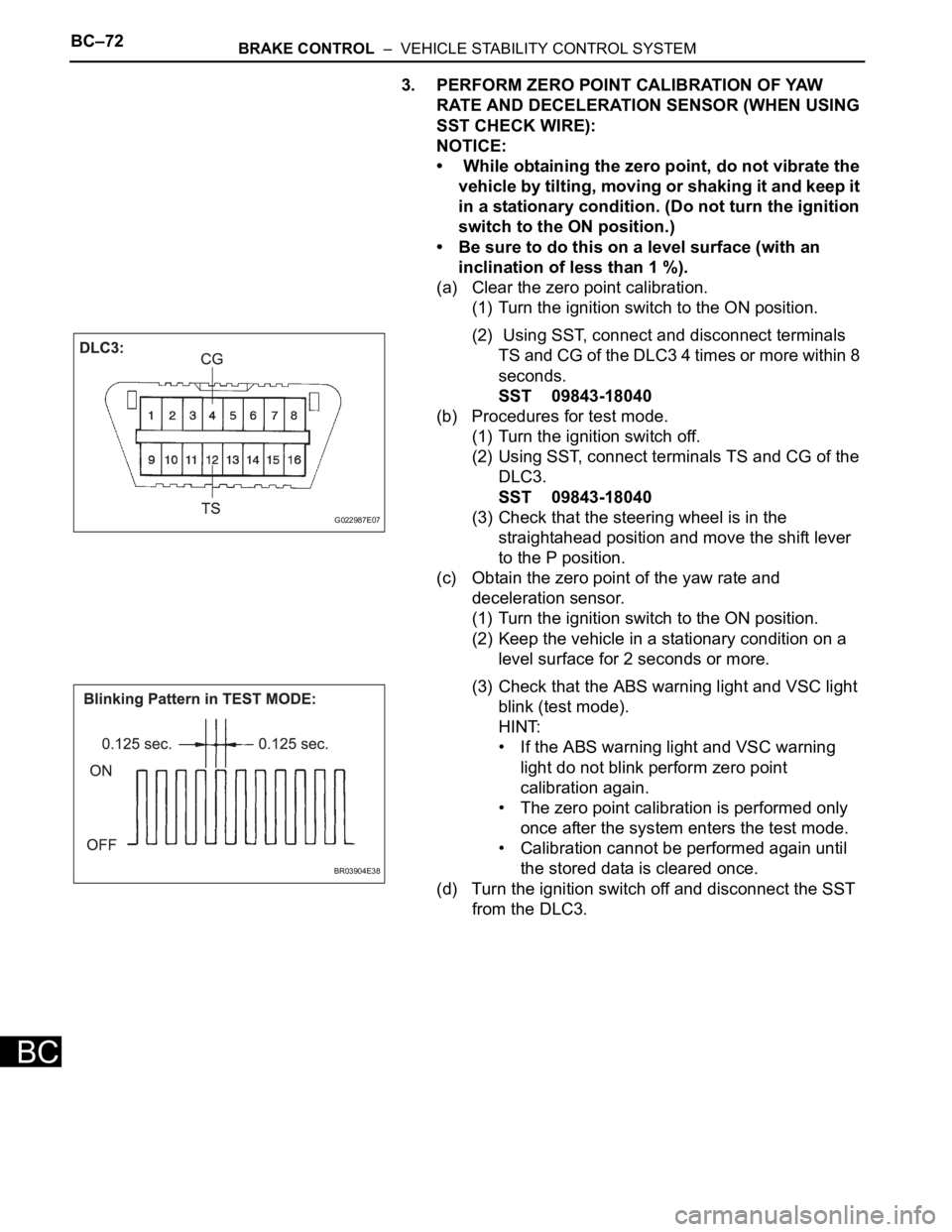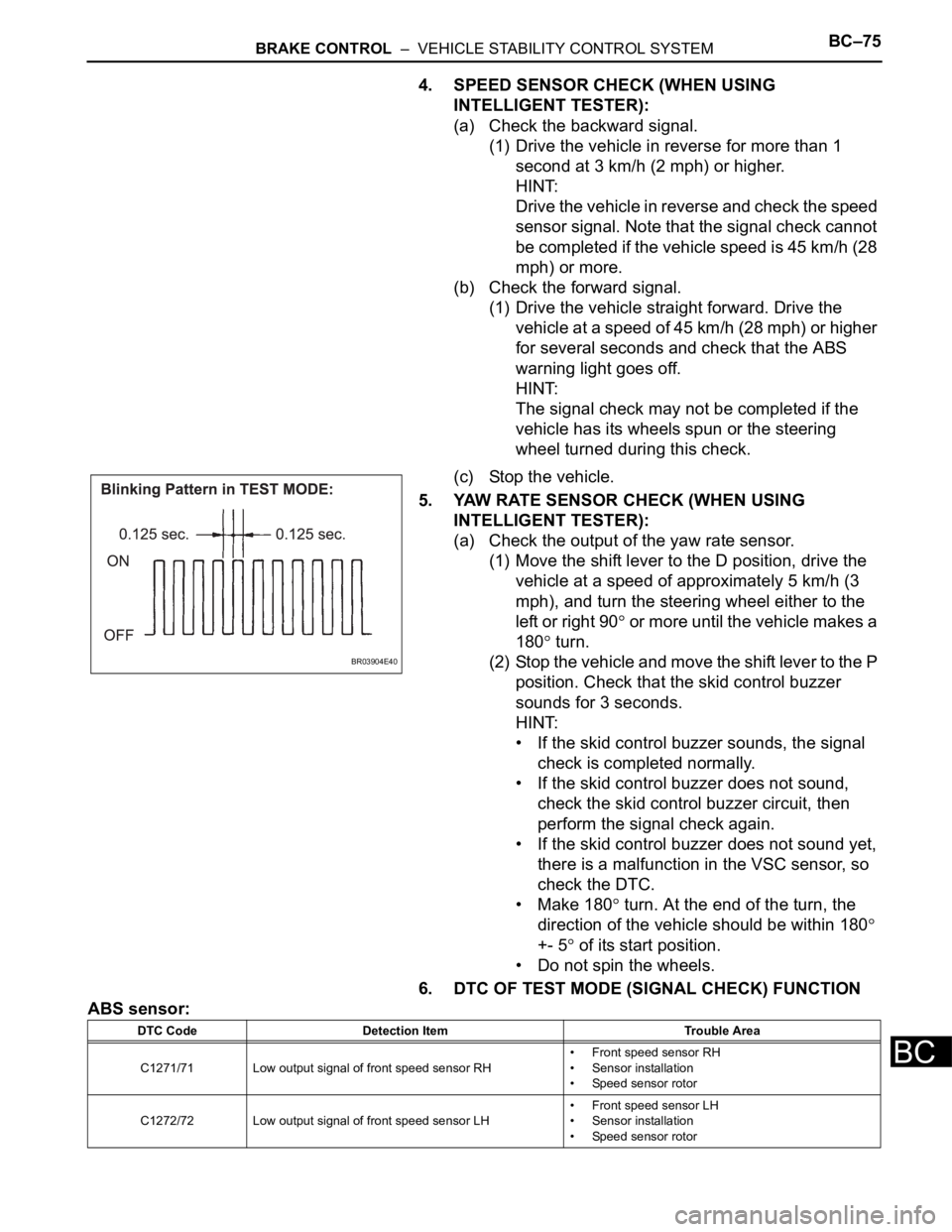2007 TOYOTA SIENNA steering wheel
[x] Cancel search: steering wheelPage 2371 of 3000

BRAKE CONTROL – ANTI-LOCK BRAKE SYSTEMBC–7
BC
(f) Check that the ABS warning light is blinking in the
Test Mode.
HINT:
If the ABS warning light does not blink, inspect the
TS and CG terminal circuit and the ABS warning
light circuit.
(g) Start the engine.
(h) Using the intelligent tester, perform the speed
sensor signal check in Test Mode.
(i) Drive the vehicle straight forward.
(j) Accelerate the vehicle to a speed of 28 mph (45 km/
h) or higher for several seconds and check that the
ABS warning light goes off.
HINT:
The signal check may not be completed if the
vehicle has its wheels spun.
(k) Stop the vehicle.
NOTICE:
• The speed sensor signal check may not be
completed if the steering wheel is turned or
the wheels are spun during the check.
• After the ABS warning light goes off and if
vehicle speed exceeds 50 mph (80 km/h), a
signal check code will be stored again.
Decelerate or stop the vehicle before the
speed reaches 50 mph (80 km/h).
• If the signal check has not been completed,
the ABS warning light blinks while driving
and the ABS system does not operate.
HINT:
When the signal check has been completed, the
ABS warning light goes off while driving and blinks
in the Test Mode pattern while stationary.
5. READ DTC
(a) Read the DTC(s) by following the tester screen.
HINT:
• Refer to the intelligent tester operator's manual
for further details.
• See the list of DTC.
6. DTC OF TEST MODE (SIGNAL CHECK) FUNCTION
BR03904E13
Trouble Area See procedure
TS and CG terminal circuitBC-64
ABS warning light circuitBC-47 or BC-50
Code No. Diagnosis Trouble Area
C1271/71 Low output signal of front speed sensor RH• Front speed sensor RH
• Sensor installation
• Speed sensor rotor
C1272/72 Low output signal of front speed sensor LH• Front speed sensor LH
• Sensor installation
• Speed sensor rotor
C1273/73 Low output signal of rear speed sensor RH• Rear speed sensor RH
• Sensor installation
• Speed sensor rotor
Page 2388 of 3000

BRAKE CONTROL – ANTI-LOCK BRAKE SYSTEMBC–21
BC
(b) Check that there is the speed value output from the
speed sensor displayed on the intelligent tester and the
speed value displayed on the speedometer are almost
the same when driving the vehicle.
OK:
The speed value output from the speed sensor
displayed on the intelligent tester is the same as
the actual vehicle speed.
NG
OK
(a) Clear the DTC (See page BC-10).
(b) Perform sensor signal check in TEST MODE
PROCEDURE (See page BC-3).
OK:
All Test Mode DTCs are erased.
OK
NG
(a) Turn the ignition switch off.
(b) Check the speed sensor installation.
OK:
The installation bolt is tightened properly.
There is no clearance between the sensor and the
front steering knuckle.
To r q u e :
8.0 N*m (82 kgf*cm, 71 in.*lbf)
NOTICE:
Check the speed sensor signal after replacement
(See page BC-3).
NG
OK
(a) Remove the front speed sensor (See page BC-187).
(b) Check the sensor tip.
WHEEL SPD FLWheel speed sensor (FL) reading
/ min.: 0 km/h (0 mph), max.: 326
km/h(202 mph)Actual wheel speedSimilar speed as indicated on
speedometer Item (Display)Measurement Item / Range
(Display)Normal Condition Diagnostic Note
Go to step 3
2PERFORM TEST MODE INSPECTION (SIGNAL CHECK)
Go to step 8
3INSPECT FRONT SPEED SENSOR INSTALLATION
BR03795E21
INSTALL FRONT SPEED SENSOR
CORRECTLY
4INSPECT SPEED SENSOR TIP
Page 2435 of 3000

BRAKE CONTROL – VEHICLE STABILITY CONTROL SYSTEMBC–71
BC
2. PERFORM ZERO POINT CALIBRATION OF YAW
RATE AND DECELERATION SENSOR (WHEN USING
INTELLIGENT TESTER):
NOTICE:
• While obtaining the zero point, do not vibrate the
vehicle by tilting, moving or shaking it and keep it
in a stationary condition. (Do not turn the ignition
switch to the ON position.)
• Be sure to do this on a level surface (with an
inclination of less than 1 %).
(a) Procedures for test mode.
(1) Check that the steering wheel is in the straight-
ahead position and move the shift lever to the P
position and apply the parking brake.
(2) Connect the intelligent tester to the DLC3.
(3) Turn the ignition switch to the ON position.
(4) Set the intelligent tester to test mode (select
"TEST MODE").
HINT:
Refer to the intelligent tester operator's manual
for further details.
(b) Obtain the zero point of the yaw rate and
deceleration sensor.
(1) Keep the vehicle in the stationary condition on a
level surface for 2 seconds or more.
(2) Check that the ABS warning light and VSC
warning light blink.
HINT:
• If the ABS warning light and VSC warning
light do not blink perform zero point
calibration again.
• The zero point calibration is performed only
once after the system enters the test mode.
• Calibration cannot be performed again until
the stored data is cleared once.
(c) Turn the ignition switch off and disconnect the
intelligent tester.
E144486E01
C106532
BR03904E37
Page 2436 of 3000

BC–72BRAKE CONTROL – VEHICLE STABILITY CONTROL SYSTEM
BC
3. PERFORM ZERO POINT CALIBRATION OF YAW
RATE AND DECELERATION SENSOR (WHEN USING
SST CHECK WIRE):
NOTICE:
• While obtaining the zero point, do not vibrate the
vehicle by tilting, moving or shaking it and keep it
in a stationary condition. (Do not turn the ignition
switch to the ON position.)
• Be sure to do this on a level surface (with an
inclination of less than 1 %).
(a) Clear the zero point calibration.
(1) Turn the ignition switch to the ON position.
(2) Using SST, connect and disconnect terminals
TS and CG of the DLC3 4 times or more within 8
seconds.
SST 09843-18040
(b) Procedures for test mode.
(1) Turn the ignition switch off.
(2) Using SST, connect terminals TS and CG of the
DLC3.
SST 09843-18040
(3) Check that the steering wheel is in the
straightahead position and move the shift lever
to the P position.
(c) Obtain the zero point of the yaw rate and
deceleration sensor.
(1) Turn the ignition switch to the ON position.
(2) Keep the vehicle in a stationary condition on a
level surface for 2 seconds or more.
(3) Check that the ABS warning light and VSC light
blink (test mode).
HINT:
• If the ABS warning light and VSC warning
light do not blink perform zero point
calibration again.
• The zero point calibration is performed only
once after the system enters the test mode.
• Calibration cannot be performed again until
the stored data is cleared once.
(d) Turn the ignition switch off and disconnect the SST
from the DLC3.
G022987E07
BR03904E38
Page 2438 of 3000

BC–74BRAKE CONTROL – VEHICLE STABILITY CONTROL SYSTEM
BC
(b) Procedures for test mode.
(1) Turn the ignition switch off.
(2) Connect the intelligent tester to the DLC3.
(3) Check that the steering wheel is in the straight
ahead position and move the shift lever to the P
position.
(4) Turn the ignition switch to the ON position.
(5) Set the intelligent tester to test mode (select
"SIGNAL CHECK").
HINT:
Refer to the intelligent tester operator's manual
for further details.
(6) Check that the ABS warning light and VSC
warning light blink (test mode).
HINT:
If the ABS warning light and VSC warning light
do not blink, inspect the ABS warning light circuit
and/or VSC warning light circuit.
3. MASTER CYLINDER PRESSURE SENSOR CHECK
(WHEN USING INTELLIGENT TESTER):
(a) Leave the vehicle in a stationary condition and
release the brake pedal for 1 second or more, and
quickly depress the brake pedal with a force of 98 N
(10 kgf, 22 lbf) or more for 1 second or more.
(b) Check the ABS warning light stays on for 3
seconds.
HINT:
• Ensure that the ABS warning light comes on.
• While the ABS warning light stays on, continue to
depress the brake pedal with a force of 98 N (10
kgf, 22 lbf) or more.
• The ABS warning light comes on for 3 seconds
every time brake pedal operation above is
performed.
E144486E01
C106533
BR03904E42
Trouble Area See procedure
ABS warning lightBC-141 or BC-145
VSC warning lightBC-147 or BC-150
Page 2439 of 3000

BRAKE CONTROL – VEHICLE STABILITY CONTROL SYSTEMBC–75
BC
4. SPEED SENSOR CHECK (WHEN USING
INTELLIGENT TESTER):
(a) Check the backward signal.
(1) Drive the vehicle in reverse for more than 1
second at 3 km/h (2 mph) or higher.
HINT:
Drive the vehicle in reverse and check the speed
sensor signal. Note that the signal check cannot
be completed if the vehicle speed is 45 km/h (28
mph) or more.
(b) Check the forward signal.
(1) Drive the vehicle straight forward. Drive the
vehicle at a speed of 45 km/h (28 mph) or higher
for several seconds and check that the ABS
warning light goes off.
HINT:
The signal check may not be completed if the
vehicle has its wheels spun or the steering
wheel turned during this check.
(c) Stop the vehicle.
5. YAW RATE SENSOR CHECK (WHEN USING
INTELLIGENT TESTER):
(a) Check the output of the yaw rate sensor.
(1) Move the shift lever to the D position, drive the
vehicle at a speed of approximately 5 km/h (3
mph), and turn the steering wheel either to the
left or right 90
or more until the vehicle makes a
180
turn.
(2) Stop the vehicle and move the shift lever to the P
position. Check that the skid control buzzer
sounds for 3 seconds.
HINT:
• If the skid control buzzer sounds, the signal
check is completed normally.
• If the skid control buzzer does not sound,
check the skid control buzzer circuit, then
perform the signal check again.
• If the skid control buzzer does not sound yet,
there is a malfunction in the VSC sensor, so
check the DTC.
• Make 180
turn. At the end of the turn, the
direction of the vehicle should be within 180
+- 5
of its start position.
• Do not spin the wheels.
6. DTC OF TEST MODE (SIGNAL CHECK) FUNCTION
ABS sensor:
BR03904E40
DTC Code Detection Item Trouble Area
C1271/71 Low output signal of front speed sensor RH• Front speed sensor RH
• Sensor installation
• Speed sensor rotor
C1272/72 Low output signal of front speed sensor LH• Front speed sensor LH
• Sensor installation
• Speed sensor rotor
Page 2440 of 3000

BC–76BRAKE CONTROL – VEHICLE STABILITY CONTROL SYSTEM
BC
VSC sensor:
HINT:
The codes in this table are output only in Test Mode
(signal check).
7. SENSOR SIGNAL CHECK BY TEST MODE (SIGNAL
CHECK) (WHEN USING SST CHECK WIRE):
(a) When having replaced the skid control ECU and/or
yaw rate and deceleration sensor, perform zero
point calibration of the yaw rate and deceleration
sensor.
HINT:
• If the ignition switch is turned from the ON
position to the ACC or off during test mode
(signal check), DTCs of the signal check function
will be erased.
• During test mode (signal check), the skid control
ECU records all DTCs of the signal check
function. By performing the test mode (signal
check), the codes are erased if normality is
confirmed. The remaining codes are the codes
where an abnormality was found.
(b) Procedures for test mode.
(1) Turn the ignition switch off.
(2) Check that the steering wheel is in the
straightahead position and move the shift lever
to the P position.
C1273/73 Low output signal of rear speed sensor RH• Rear speed sensor RH
• Sensor installation
• Speed sensor rotor
C1274/74 Low output signal of rear speed sensor LH• Rear speed sensor LH
• Sensor installation
• Speed sensor rotor
C1275/75Abnormal change in output signal of front speed sensor
RHSpeed sensor rotor
C1276/76Abnormal change in output signal of front speed sensor
LHSpeed sensor rotor
C1277/77Abnormal change in output signal of rear speed sensor
RHSpeed sensor rotor
C1278/78Abnormal change in output signal of rear speed sensor
LHSpeed sensor rotor
C1279/79 Acceleration sensor output voltage malfunction• Yaw rate and deceleration sensor
• Sensor installation
C1281/81 Master cylinder pressure sensor output malfunction• Stop light switch
• Master cylinder pressure sensor
DTC Code Detection Item Trouble Area
C0371/71 Yaw rate sensor Yaw rate and deceleration sensor DTC Code Detection Item Trouble Area
Page 2442 of 3000

BC–78BRAKE CONTROL – VEHICLE STABILITY CONTROL SYSTEM
BC
9. SPEED SENSOR CHECK (WHEN USING SST CHECK
WIRE):
(a) Check the speed sensor signal.
(1) Drive the vehicle straight forward. Drive the
vehicle at a speed of 45 km/h (28 mph) or higher
for several seconds and check that the ABS
warning light goes off.
HINT:
The signal check may not be completed if the
vehicle has its wheels spun or the steering
wheel turned during this check.
(b) Stop the vehicle.
NOTICE:
• Before performing the speed sensor signal
check, complete the deceleration sensor and
master cylinder pressure sensor checks.
• The speed sensor signal check may not be
completed if the speed sensor signal check is
started while turning the steering wheel or
spinning the wheels.
• After the ABS warning light goes off, if
vehicle speed exceeds 80 km/h (50 mph), a
signal check code will be stored again.
Decelerate or stop the vehicle before the
speed reaches 80 km/h (50 mph).
• If the signal check has not been completed,
the ABS warning light blinks while driving
and the ABS system does not operate.
HINT:
When the signal check has been completed, the
ABS warning light goes off while driving and blinks
in the test mode pattern while stationary.
10. YAW RATE SENSOR CHECK (WHEN USING SST
CHECK WIRE):
(a) Check the zero point voltage of the yaw rate sensor.
(1) Keep the vehicle in a stationary condition on a
level surface for 1 second or more.
(b) Check the output of the yaw rate sensor.
(1) Move the shift lever to the D position, drive the
vehicle at a speed of approximately 3 mph (5
km/h), and turn the steering wheel either to the
left or right 90
or more until the vehicle makes
180
turn.
(2) Stop the vehicle and move the shift lever to the
position. Check that the skid control buzzer
sounds for 3 seconds.
HINT:
• If the skid control buzzer sounds, the signal
check is completed normally.
• If the skid control buzzer does not sound,
check the skid control buzzer circuit, then
perform the signal check again.